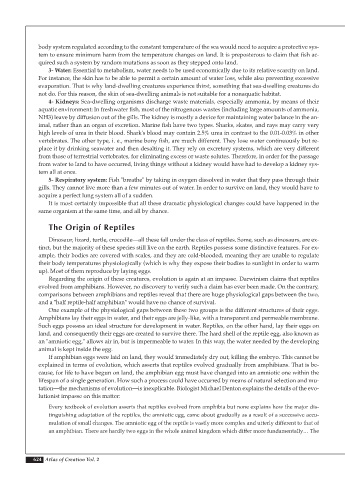Page 626 - Atlas of Creation Volume 2
P. 626
body system regulated according to the constant temperature of the sea would need to acquire a protective sys-
tem to ensure minimum harm from the temperature changes on land. It is preposterous to claim that fish ac-
quired such a system by random mutations as soon as they stepped onto land.
3- Water: Essential to metabolism, water needs to be used economically due to its relative scarcity on land.
For instance, the skin has to be able to permit a certain amount of water loss, while also preventing excessive
evaporation. That is why land-dwelling creatures experience thirst, something that sea-dwelling creatures do
not do. For this reason, the skin of sea-dwelling animals is not suitable for a nonaquatic habitat.
4- Kidneys: Sea-dwelling organisms discharge waste materials, especially ammonia, by means of their
aquatic environment: In freshwater fish, most of the nitrogenous wastes (including large amounts of ammonia,
NH3) leave by diffusion out of the gills. The kidney is mostly a device for maintaining water balance in the an-
imal, rather than an organ of excretion. Marine fish have two types. Sharks, skates, and rays may carry very
high levels of urea in their blood. Shark's blood may contain 2.5% urea in contrast to the 0.01-0.03% in other
vertebrates. The other type, i. e., marine bony fish, are much different. They lose water continuously but re-
place it by drinking seawater and then desalting it. They rely on excretory systems, which are very different
from those of terrestrial vertebrates, for eliminating excess or waste solutes. Therefore, in order for the passage
from water to land to have occurred, living things without a kidney would have had to develop a kidney sys-
tem all at once.
5- Respiratory system: Fish "breathe" by taking in oxygen dissolved in water that they pass through their
gills. They cannot live more than a few minutes out of water. In order to survive on land, they would have to
acquire a perfect lung system all of a sudden.
It is most certainly impossible that all these dramatic physiological changes could have happened in the
same organism at the same time, and all by chance.
The Origin of Reptiles
Dinosaur, lizard, turtle, crocodile—all these fall under the class of reptiles. Some, such as dinosaurs, are ex-
tinct, but the majority of these species still live on the earth. Reptiles possess some distinctive features. For ex-
ample, their bodies are covered with scales, and they are cold-blooded, meaning they are unable to regulate
their body temperatures physiologically (which is why they expose their bodies to sunlight in order to warm
up). Most of them reproduce by laying eggs.
Regarding the origin of these creatures, evolution is again at an impasse. Darwinism claims that reptiles
evolved from amphibians. However, no discovery to verify such a claim has ever been made. On the contrary,
comparisons between amphibians and reptiles reveal that there are huge physiological gaps between the two,
and a "half reptile-half amphibian" would have no chance of survival.
One example of the physiological gaps between these two groups is the different structures of their eggs.
Amphibians lay their eggs in water, and their eggs are jelly-like, with a transparent and permeable membrane.
Such eggs possess an ideal structure for development in water. Reptiles, on the other hand, lay their eggs on
land, and consequently their eggs are created to survive there. The hard shell of the reptile egg, also known as
an "amniotic egg," allows air in, but is impermeable to water. In this way, the water needed by the developing
animal is kept inside the egg.
If amphibian eggs were laid on land, they would immediately dry out, killing the embryo. This cannot be
explained in terms of evolution, which asserts that reptiles evolved gradually from amphibians. That is be-
cause, for life to have begun on land, the amphibian egg must have changed into an amniotic one within the
lifespan of a single generation. How such a process could have occurred by means of natural selection and mu-
tation—the mechanisms of evolution—is inexplicable. Biologist Michael Denton explains the details of the evo-
lutionist impasse on this matter:
Every textbook of evolution asserts that reptiles evolved from amphibia but none explains how the major dis-
tinguishing adaptation of the reptiles, the amniotic egg, came about gradually as a result of a successive accu-
mulation of small changes. The amniotic egg of the reptile is vastly more complex and utterly different to that of
an amphibian. There are hardly two eggs in the whole animal kingdom which differ more fundamentally… The
624 Atlas of Creation Vol. 2

